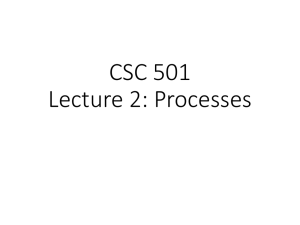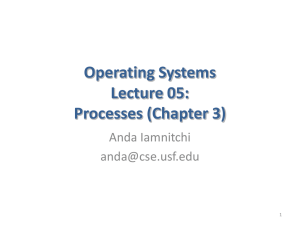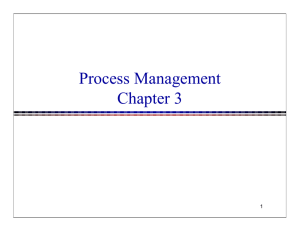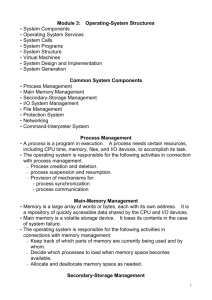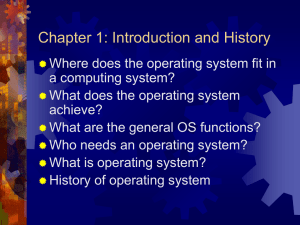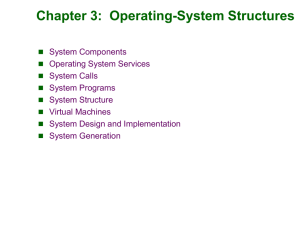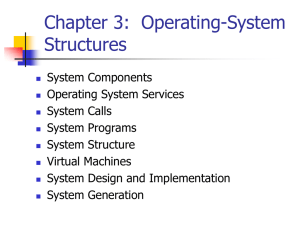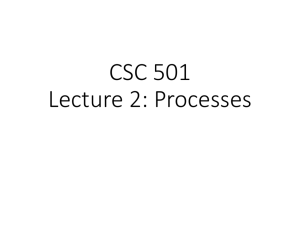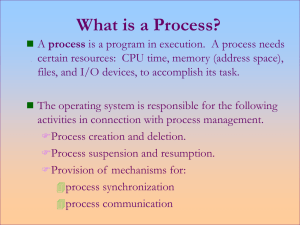Process Description and Control in Operating Systems
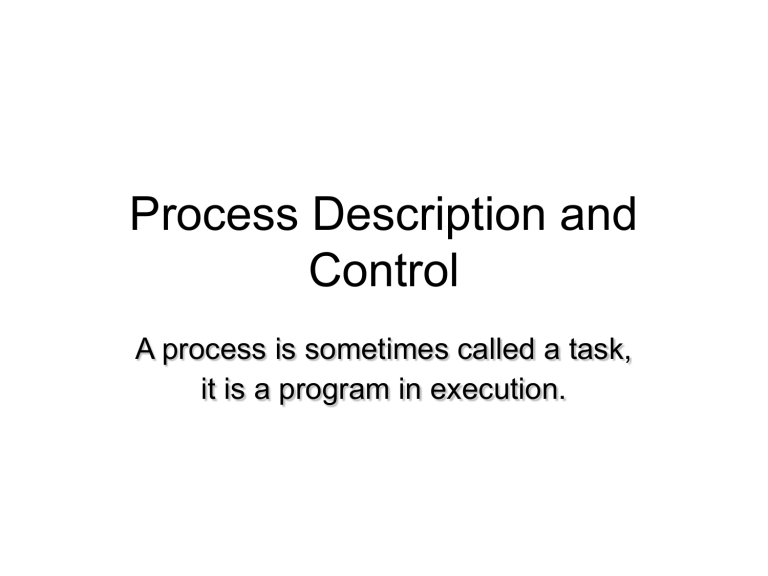
Process Description and
Control
A process is sometimes called a task, it is a program in execution.
OS Requirements for Processes
• OS must interleave the execution of several processes to maximize CPU usage while providing reasonable response time
• OS must allocate resources to processes while avoiding deadlock
• OS must support inter process communication and user creation of processes
Short-term Process scheduler
• Is an OS program that moves the processor from one process to another
• It prevents a single process from monopolizing processor time
• It decides who goes next according to a scheduling algorithm
• The CPU will always execute instructions from the dispatcher while switching from process A to process B
When does a process gets created?
• Submission of a batch job
• User logs on
• Created by OS to provide a service to a user (ex: printing a file)
• Spawned by an existing process a user program can dictate the creation of a number of processes
When does a process gets terminated?
• Batch job issues Halt instruction
• User logs off
• Process executes a service request to terminate
• Error and fault conditions
Reasons for Process Termination
•
Normal completion
•
Time limit exceeded
•
Memory unavailable
• Memory bounds violation
• Protection error example: write to read-only file
•
Arithmetic error
•
Time overrun process waited longer than a specified maximum for an event
• I/O failure
•
Invalid instruction happens when try to execute data
•
Privileged instruction
• Operating system intervention such as when deadlock occurs
• Parent request to terminate one offspring
•
Parent terminates so child processes terminate
Main Process States
• The Running state
The process that gets executed (single CPU)
• The Ready state any process that is ready to be executed
• The Blocked (wait) state when a process cannot execute until some event occurs (ex: the completion of an I/O)
• Other useful states do exist!
Process Image (process constituents)
• User program
• User data
• Stack(s) for procedure calls and parameter passing
• Process Control Block-PCB (execution context)
Data needed (process attributes) by the OS to control the process. This includes:
– Process identification information (process id, user id, parent id)
– Processor state information (registers: pc, sp, psw, etc.)
– Process control information (scheduling inf., memory mngt, resource use, links between data structures, etc.)
Modes of Execution
To provide protection to PCBs (and other OS data) most processors support at least 2 execution modes:
• Privileged mode (a.k.a. system mode, kernel mode, supervisor mode, control mode)
Manipulating control registers, primitive I/O instructions, memory management...
• User mode
For this the CPU provides a (or a few) mode bit which may only be set by an interrupt or trap or OS call
Process Creation
• Assign a unique process identifier
• Allocate space for the process image
• Initialize process control block
• Set up appropriate linkages
When to Switch a Process ?
A process switch may occur whenever the OS has gained control of CPU, i.e. when:
• Supervisor Call
• Explicit request by the program
The process will probably be blocked
• Trap
An error resulted from the last instruction. It may cause the process to be moved to the Exit state
• Interrupt
The cause is external to the execution of the current instruction. Control is transferred to IH
Examples of interrupts
• Clock
• I/O process has expired his time slice and is transferred to the ready state first move the processes that where waiting for this event to the ready (or ready suspend) state, then resume the running process or choose a process of higher priority
• Memory fault memory address is in virtual memory so it must bring corresponding block into main memory, thus move this process to a blocked state (waiting for the I/O to complete)
Steps in Process (Context)
Switching
• Save context of processor including program counter and other registers
• Update the PCB of the running process with its new state and other associate info
• Move PCB to appropriate queue - ready, blocked
• Select another process for execution
• Update PCB of the selected process
• Restore CPU context from that of the selected process
UNIX SVR4 Process management
Most of OS executes within user processes
Uses two categories of processes:
• System processes
Run in kernel mode for housekeeping functions
(memory allocation, process swapping...)
• User processes
Run in user mode for user programs
Run in kernel mode for system calls, traps, and interrupts
UNIX Process Creation
Every process, except process 0, is created by the fork() system call
• fork() allocates entry in process table and assigns a unique PID to the child process
• child gets a copy of process image of parent: both child and parent are executing the same code following fork()
• but fork() returns the PID of the child to the parent process and returns 0 to the child process
UNIX System Processes
• Process 0 is created at boot time and becomes the “swapper” after forking process 1 (the INIT process)
• When a user logs in: process 1 creates a process for that user
• UNIX Process Image
• User-level context
Process Text (i.e. code: read-only)
Process Data
User Stack (calls/returns in user mode)
Shared memory only one physical copy exists but, with virtual memory, it appears as it is in the process’s address space
• Register context
• System-level context
Process table entry the actual entry concerning this process in the Process Table maintained by OS
Process state
UID, PID, priority, event awaiting, signals sent, pointers to memory holding text, data...
U (user) area additional process info needed by the kernel when executing in the context of this process effective UID, timers, limit fields, files in use ...
Kernel stack
(calls/returns in kernel mode)
Per Process Region Table
(used by memory manager)

